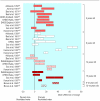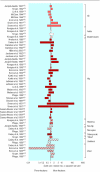Systematic review of water fluoridation
- PMID: 11021861
- PMCID: PMC27492
- DOI: 10.1136/bmj.321.7265.855
Systematic review of water fluoridation
Abstract
Objective: To review the safety and efficacy of fluoridation of drinking water.
Design: Search of 25 electronic databases and world wide web. Relevant journals hand searched; further information requested from authors. Inclusion criteria were a predefined hierarchy of evidence and objectives. Study validity was assessed with checklists. Two reviewers independently screened sources, extracted data, and assessed validity.
Main outcome measures: Decayed, missing, and filled primary/permanent teeth. Proportion of children without caries. Measure of effect was the difference in change in prevalence of caries from baseline to final examination in fluoridated compared with control areas. For potential adverse effects, all outcomes reported were used.
Results: 214 studies were included. The quality of studies was low to moderate. Water fluoridation was associated with an increased proportion of children without caries and a reduction in the number of teeth affected by caries. The range (median) of mean differences in the proportion of children without caries was -5.0% to 64% (14.6%). The range (median) of mean change in decayed, missing, and filled primary/permanent teeth was 0.5 to 4.4 (2.25) teeth. A dose-dependent increase in dental fluorosis was found. At a fluoride level of 1 ppm an estimated 12.5% (95% confidence interval 7.0% to 21.5%) of exposed people would have fluorosis that they would find aesthetically concerning.
Conclusions: The evidence of a beneficial reduction in caries should be considered together with the increased prevalence of dental fluorosis. There was no clear evidence of other potential adverse effects.
Figures





Comment in
-
Fluoridation, fractures, and teeth.BMJ. 2000 Oct 7;321(7265):844-5. doi: 10.1136/bmj.321.7265.844. BMJ. 2000. PMID: 11021844 Free PMC article. No abstract available.
References
-
- Secretary of State for Health. Saving lives: our healthier nation. London: Stationery Office; 1999.
-
- NHS CRD. A systematic review of public water fluoridation. York: NHS Centre for Reviews and Dissemination. University of York; 2000. . (Report 18.)
-
- NHS CRD. Undertaking systematic reviews of research on effectiveness. York: NHS Centre for Reviews and Dissemination, University of York; 1996. . (Report 4.)
-
- Thompson SG, Sharp SJ. Explaining heterogeneity in meta-analysis: a comparison of methods. Stat Med. 1999;18:2693–2708. - PubMed
-
- Dersimonian R, Laird N. Meta-analysis in clinical trials. Cont Clin Trials. 1986;7:177–188. - PubMed
Publication types
MeSH terms
LinkOut - more resources
Full Text Sources
Medical
